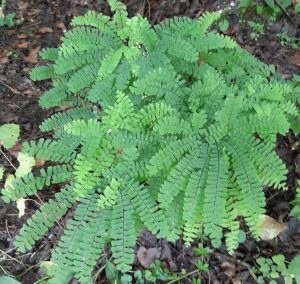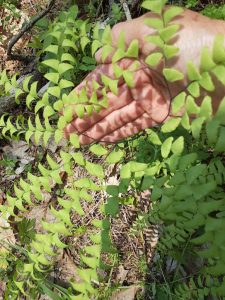By Susan Sprout
These elegant-looking perennial ferns, preferring acid soil and partial shade, are likely to be found on wooded slopes and ravine bottoms that are moist. They “brown-up” early in summer when they are too dry. Northern Maidenhair Fern or Adantium pedatum is the Eastern North American native of this genus growing world-wide that has nearly two hundred different species in it. I love looking for their circular patterns of horizontal fronds and bright green leaflets divided into little fan shapes! They are lacy and delicate. The shiny black stems holding them all together are a great clue when trying to identify Maidenhair Fern, and thus, the name. And they are tough! They were used by Native Americans in their basket-making. With many other ferns, there is an observable difference between fertile fronds carrying spores and non-fertile fronds without them. Not so with Maidenhair! Their foliage looks the same until you turn one over and find little sori curled up on underside edges behind the vein tips of the leaflet. Though tiny and tucked away, wind will disperse the spores to grow into heart-shaped gametophytes responsible for sexual reproduction and creation of the next generation of ferns. Over time, they will grow into colonies, spread by their underground rhizomes. In spring, look for the pinkish-brown crosiers or shepherd’s crooks pushing up. Return trips are a must…to see them gracefully unfurl!



